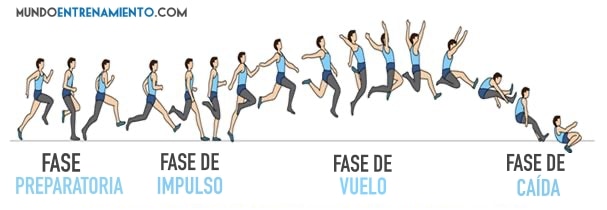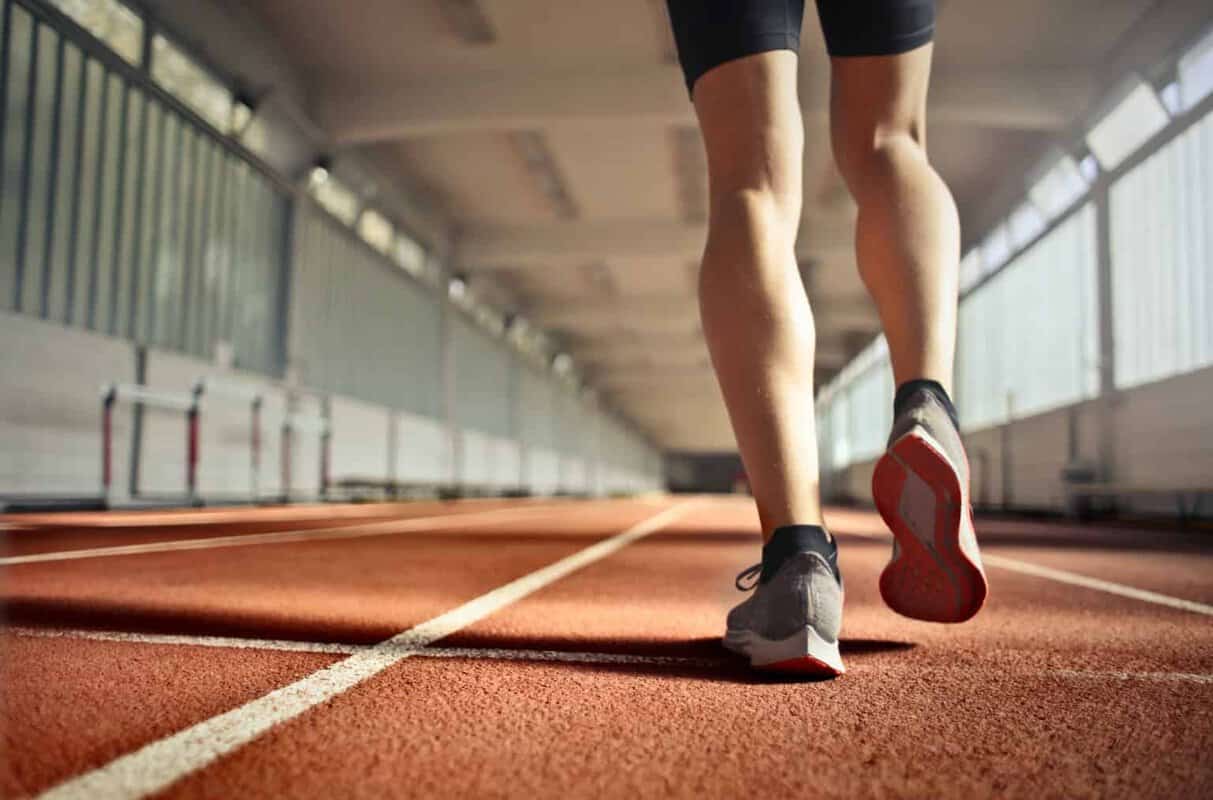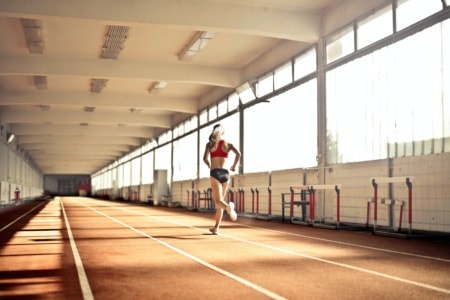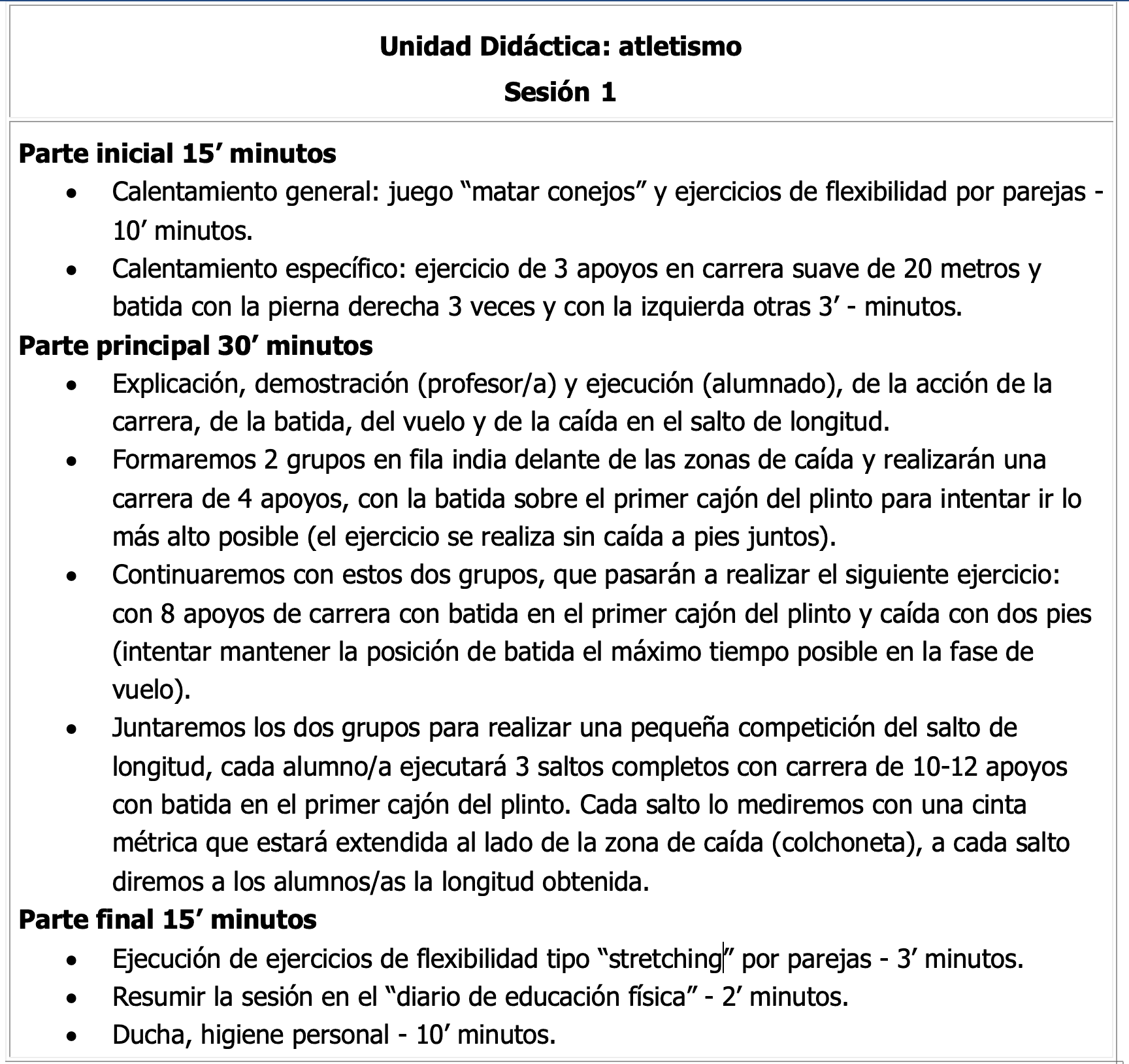In the following article, a specific content is addressed within the possibilities offered in individual or interindividual opposition sports in Physical Education. The chosen sport is athletics and within this, the horizontal jump in Physical Education.
What do we understand by horizontal jump?
The jump is part of the basic motor skills, it is a skill inherent to the human species that involves the body’s takeoff from the ground, through an impulse mainly performed by the flexion of the legs, which after their extension leaves the body suspended in the air for a determined time.
The jump is an elementary locomotor pattern that originates from the locomotor patterns of walking and running (1).
As we say, the origin comes from the running pattern, but it differs from this because it requires higher levels of propulsion, balance, and movement coordination (2).
Regardless of the type of jump performed, there are common phases to all of them: preparatory, impulse, flight, and landing or cushioning.
- Preparatory: it is the set of preliminary actions to prepare the impulse or takeoff performed in the second phase.
- Impulse: flexion-extension of the lower limbs, action of the extensor muscles that, accompanied by the joint action of the rest of the limbs (also the strength of the arms is fundamental) causes the body’s takeoff in the flight phase.
- Flight: phase in which the body loses contact with the surface from which it took the impulse. In this phase, balance control is fundamental to progress according to the jump’s objective and facilitate its landing.
- Landing: also called the cushioning phase, the moment when the feet make contact with the ground.

The horizontal jump is a modality within jumps in athletics, where the subject aims to achieve the most horizontal displacement possible without touching the ground.
In competition, the greater the jump, the higher the probability of surpassing the opponent. It is usually performed starting with feet together and gaining momentum to achieve the greatest possible distance.
The horizontal jump in Physical Education
The main objective of the horizontal jump in Physical Education is to measure or assess the explosive strength of the lower body (3).
It is usually evaluated during the initial assessment of the course, and later in the final assessment, both in students of the last years of Primary and in Secondary Education.
In this way, the improvement that students have had during the school year in terms of physical condition can be observed, as we said, specifically the explosive strength of the lower body.
It can also be worked on as part of the athletics content if the aim is to work on and introduce the different modalities it presents: running, jumping, and throwing.
Or as part of isolated sessions or didactic units of physical condition in which several sessions are grouped related to endurance, strength, flexibility, and speed.
Within which, the content of jumps would be part of the strength sessions, in these the objective could be working on the horizontal jump as an option to improve the strength of the lower limbs, or as an evaluation for the same.
Considering that the time required to really observe the improvement of strength is much greater than the possibility offered by conducting 3-4 strength sessions in the subject of Physical Education.
Despite this last point, it is of great interest that students know options and utilities of the tests and contents related to jumping and particularly with the horizontal jump, as they can be useful for practicing them in their leisure time outside the school environment.
For the treatment of the horizontal jump in physical education, a series of aspects must be taken into account, among which are the following (4):
- Up to 17 years in boys, significant improvements in horizontal jump values can be observed.
- Up to 13 years, this great improvement is observed in the case of females.
- Between 13 to 15 years, there are no significant changes, however, from 15 to 17 years, there is again a significant increase in leg power.
- Additionally, the increase in fatty tissue is detrimental to the performance of the horizontal jump, especially affecting those who are overweight or obese.
Based on these aspects, it can be thought that the incorporation of strength physical activities within physical education classes is fundamental since adolescents are in sensitive phases during adolescence to work on jumping and improve strength as a basic physical capacity.
How to improve the horizontal jump?
The best option to improve the horizontal jump mark is to work on specific sessions of mobility, technique, and strength.
The horizontal jump in physical education requires great coordination of upper and lower limbs, this combined with the different phases requires working on the technique to optimize performance to the maximum or at least adapt to a correct technique as much as possible.
Regarding strength work, it is advisable to train maximum strength, weight training through Olympic lifts, work on power, as well as plyometric exercises.
Regarding mobility, the greater the range of mobility we can achieve in the different joints, the greater the impulse we can achieve and better technique, which translates into an improvement in the result of the horizontal jump in physical education.
Practical proposal for jumping in physical education
As mentioned, one of the available options for working on the horizontal jump in Physical Education is the treatment of a didactic unit of physical condition, which could consist of 16 sessions.
The duration of each session of horizontal jump practice in physical education, within educational centers, is 50 minutes which we must try to make the most of, and this unit is carried out over 8 consecutive weeks.
Thus seeking to achieve an improvement in their physical condition that can be observable as much as possible, focusing on the achievements of the horizontal jump.
The main work of the unit focuses on strength, therefore the sessions of the didactic unit should focus on toning activities in which students can acquire knowledge about the correct use of the material and the appropriate technique in the exercises, which they can later apply outside the center.
Likewise, recreational activities such as cooperative and opposition games are carried out to foster student motivation and at the same time work on strength and more specifically lower body strength to achieve improvements in the jump (5).
Below is a session for working on the horizontal jump (6):
Conclusions
The main objective of the horizontal jump in Physical Education is to assess the strength of the lower body.
To make this assessment of the horizontal jump in Physical Education, it is advisable to work on strength and then analyze it again, thus being able to observe the students’ improvements.
This is because it makes no sense to evaluate a physical condition capacity if it is not going to be worked on nor are tools and resources going to be provided to students to expand their knowledge and possibilities for work and improvement.
Bibliographic references
- Prieto, M. Á., & Física, E. (2010). Basic motor skills. Montalbán Córdoba, Spain. Retrieved from: https://archivos.csif.es/
- Wickstrom, R. (1990) Basic motor patterns. Madrid, Alianza.
- Martínez López, E. J. (2003). Application of the medicine ball throw test, upper abs, and horizontal jump with feet together: results and statistical analysis in secondary education.
- Gómez-Campos, R., Flores, I. C., Cornejo, J. M., Fuentes, P. P., Albornoz, C. U., & Cossio-Bolaños, M. A. (2019). Body adiposity is related to horizontal jump performance in children. Challenges: new trends in physical education, sport, and recreation, (36), 370-375.
- Castillo Alvira, D., Rodríguez-Negro, J., & Yanci Irigoyen, J. (2017). Effect of a Physical Condition Didactic Unit on the horizontal jump capacity in high school students. Sportis, 3(1), 161-172. Retrieved from: https://ruc.udc.es/
- Palau, X. (2010). Athletics Didactic Unit: let’s jump… EFdeportes,14 (142).



